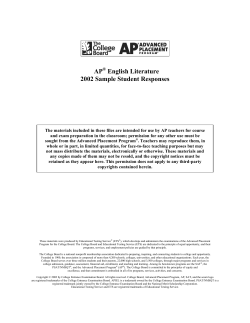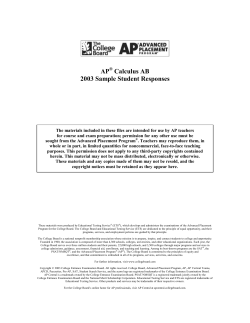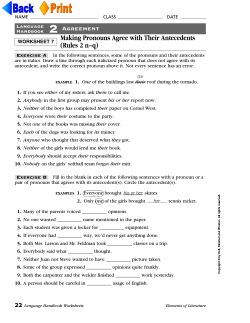
• Skills Tested on the PSAT/NMSQT • Sample PSAT/NMSQT Questions
• Skills Tested on the PSAT/NMSQT • Sample PSAT/NMSQT Questions • Scoring the PSAT/NMSQT • Test Preparation Strategies • Measures academic skills you’ll need for college • Co-sponsored by the College Board and National Merit Scholarship Corporation • Serves as an entry point to National Merit Scholarship Corporation competitions and practice for the SAT • Taken by more than 3.5 million students in 2008 (45% eleventh-graders and 55% tenth-graders or younger) • Preparation for the SAT® • Scholarship and recognition opportunities (11th grade) • College and career planning tools • Admissions and financial aid information from colleges • Feedback on academic skills The test assesses the academic skills that you’ve developed over the years, primarily through your course work. These skills are considered essential for success in high school and college: •Critical Reading •Mathematics •Writing Skills Use content from: -humanities -social studies -natural sciences -literature •13 Sentence Completions •35 Passage-Based Reading Questions (100- to 800-word passages) Use content from: -number and operations -algebra and functions; -geometry and measurement -data analysis -statistics -probability •28 Multiple-Choice Questions •10 Student-Produced Response Questions (“Grid-ins”) Focus on editing, grammar, usage, and organization. •20 Improving Sentences Questions •14 Identifying Sentence Error Questions •5 Improving Paragraph Questions • Question Types: The same, except the PSAT/NMSQT does not have an essay component. • Length: The PSAT/NMSQT is 2 hours, 10 minutes. The SAT is 3 hours, 45 minutes. • Level of Difficulty: The PSAT/NMSQT does not have 11th grade-level math questions. Roger said the report was significant; Heather contradicted him, saying that all the information presented was _______ . (A) contemporary (B) scintillating (C) objective (D) irrevocable (E) immaterial Because Heather is contradicting Roger, the correct response is the word that is most nearly the opposite of “significant.” Choice (E) is correct. “Immaterial” means inconsequential or irrelevant. Information that is immaterial is by definition not significant. Passage Excerpt: After I left the room, I began to sift my impressions. Only the day before, an acquaintance had warned me to watch carefully for sleight-of-hand tricks, especially as the man had earlier been a stage conjuror. Question: The “acquaintance” mentioned in line 2 can best be described as a (A) skeptic (B) hypocrite (C) hoaxer (D) confidant (E) mystic The acquaintance mentioned in line 2 warns the author to “watch carefully for sleight-of-hand tricks.” Choice (A) is correct. In warning the author to watch out for tricks, the acquaintance is showing that he is skeptical about the telepathist's supposed powers. If ax + bx = 36, what is the value of x when a + b = 12? (A) 3 (B) 6 (C)12 (D) 24 (E) 48 The expression ax + bx is equivalent to (a + b) x, so the equation ax + bx = 36 is equivalent to (a + b) x = 36. When a + b = 12, the equation becomes 12x = 36, which can be solved to get x = 3. If h 4 4 / 1 3 + = 5h 6 , then what is the value of h? 7 • Multiply each member of the equation by 12 (the common denominator) to get 3h + 4 = 10h • Subtract 3h from both sides to get 7h = 4 • Divide by 7 • h = 4/7. Know the Student-Produced Response Directions! The correct answer must be gridded correctly to receive credit. What is written in the boxes cannot be scored. $1.75 1 . 7 5 7 2⅓ 0.444… / . 3 4 4 4 20% . 2 A scientific or graphing calculator is recommended. Bring a familiar calculator. Test day is not the time to figure out how to use a new calculator. A few barges still move oil up to Hartford, but in the old days they had more traffic then. (A) but in the old days they had more traffic then (C) but in the old days traffic was heavier (E) but in the old days they had a lot more (G) whereas the traffic was a lot more in the old days (E) whereas then there was more traffic in the old days (Note: In this question type, the first choice (A) always repeats the underlined phrase exactly, indicating that there should be no change.) Choice (B) is correct. It avoids the errors of the original by eliminating both the unnecessary adverb, “then,” and the vague pronoun, “they.” The electronic computer is a technological triumph that scientists have developed, mastered, and then put it to constantly increasing use. No Error. A B C D E The error in this sentence occurs at (B), where an unnecessary pronoun is used. The object of the verb “have . . . put” (like the object of the verbs “have developed” and “have . . . Mastered”) is the relative pronoun “that,” which refers to “technological triumph.” The pronoun “it” is therefore unnecessarily inserted after “put.” (1) The last century was a time of great technological progress. (2) Life is more convenient, comfortable, and efficient today than ever before. (3) Yet this has created new concerns. Which of the following versions of sentence 3 (reproduced below) is most effective? Yet this has created new concerns. (E)Although this has created new concerns. (G)Yet this progress has created new concerns. (I)Yet these have created new concerns. (K)Yet this has created new concerns to worry about. (M)New concerns have been created. Choice (B) is correct. The vague pronoun “this” is replaced by “this progress,” which clearly refers to the progress mentioned in sentence 1. The PSAT/NMSQT Score Report: • contains information to help you improve your academic skills. • lists skills that you have the best chance of improving with additional work. • includes advice, written by teachers, on how to improve those skills. READ! •Continuous reading improves vocabulary and develops essential skills. •Read more books than just those required for class. Take Challenging Courses! •This will help you to develop and strengthen your critical thinking skills. • Take the practice test in the Official Student Guide to the PSAT/NMSQT. • Understand scoring and “educated guessing.” • Familiarize yourself with the test’s format, questions types, and directions. When you sit down to take the test: • • • • Read all of the directions. Read all of each question’s answer choices. Do scratch work in the test book. Work at a steady pace. If you skip a question: • • • • Note it in the test book. Leave it blank on the answer sheet. Return to it if there is time. Remember: you don’t have to answer every question to score well. In most sections, the questions are arranged from easy to more difficult (except for passage-based reading in the critical reading section and improving paragraphs in the writing skills section). Wild guessing is discouraged, but students should make educated guesses when answer choices can be eliminated. 1. 2. 3. 4. 5. 6. 7. 8. 9. 10. A A A A A A A A A A B B B B B B B B B B C C C C C C C C C C D D D D D D D D D D E E E E E E E E E E 1. 2. 3. 4. 5. 6. 7. 8. 9. 10. A A A A A A A A A A B B B B B B B B B B C C C C C C C C C C D D D D D D D D D D E E E E E E E E E E 1. 2. 3. 4. 5. 6. 7. 8. 9. 10. A A A A A A A A A A B B B B B B B B B B C C C C C C C C C C D D D D D D D D D D E E E E E E E E E E How to Sign Up: _____________________________________ Test Day/Date: _____________________________________ Time: _____________________________________ Location: _____________________________________ Bring: • Two #2 Pencils • Calculator (optional)
© Copyright 2025




















